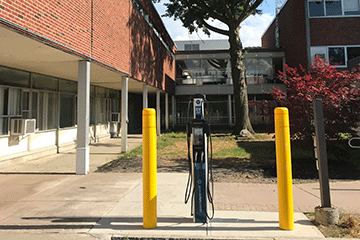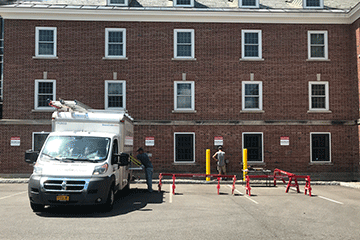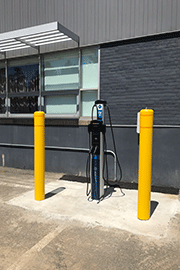
09/01/2020
Starting this fall, SUNY Cortland offers campus community members the option to recharge the battery on their personal electric vehicles (EVs) on campus for a small fee while they go about their daily activities.
The campus in adding four charging stations becomes the first Cortland County entity to participate in a program supporting electric vehicle use offered by National Grid.
The new charging stations for the commuter’s passenger vehicles were installed in late August at four locations: behind DeGroat Hall, outside Neubig Hall, behind Van Hoesen Hall beside the nearest entrance to the Student Health Service, and next to the Professional Studies Building.

For some years, SUNY Cortland has demonstrated its green transportation credentials with some 20 electricity-powered GEM cars, always ready to whisk faculty, staff and visitors across campus at low speeds. The campus has also encouraged carpooling, offered a community bikes program and arranged for a shuttle bus with Cortland First Transit to provide several stops through and near campus.
This time, the university takes its sustainability commitment to a new level so that faculty, staff and students need not leave their EVs parked at home and take their gasoline engine transportation instead when they want to commute to campus.
“Encouraging people with electric vehicles is a great step forward,” said Matthew Brubaker, campus energy manager with Facilities Operations and Services at Cortland.
Only about five registered parking permit holders presently drive EVs. With this convenience the number could rise.
“Over the past 12 months, I’ve been asked by three or four people when we would get a charging station,” Brubaker said. “One of them was a student, possibly just visiting and deciding what type of transportation is possible. It was one of the particular things this student highlighted that they were interested in.”
Each station can charge up to two vehicles simultaneously. Anyone who wishes to replenish the battery in their vehicle can do so at the charging stations, whether or not they have a SUNY Cortland parking permit. Campus parking permit holders are served during business hours and anyone can use them after 5 p.m.
The spaces associated with the stations are reserved for EVs that are currently charging and may be used for up to four hours at a time, according to Brubaker. Individuals whose parked vehicles are not charging or that overstay the time limit will be ticketed.
“People are not supposed to park their regular, gas combustion engine vehicle in these parking slots,” Brubaker said. “The exception is the charger near Neubig Hall, which has parking meters as well as charging stations, the parking meter is good for only 45 minutes of parking at a time. Any vehicle can park there. But an EV can park there for four hours and will not be charged to be there. Owners of gas engine vehicles will pay to park for 45 minutes there.”
With these additions, SUNY Cortland continues toward its long-term goal of environmental sustainability.
“In New York, more than 41% of our greenhouse gas emissions come from transportation,” Brubaker said. “In order to reduce emissions and fight climate change, experts agree that we need to rapidly decrease our dependence on conventional vehicles and increase adoption of EVs.”
He pointed out that, while there are still emissions associated with producing the electricity to charge the vehicles, because of New York’s advances in clean energy, charging one’s EVs in the state produces far fewer greenhouse gases.
Better still, he noted, electric vehicles produce no tailpipe emissions, which are the source of most of the smog and air pollution that cause so many health problems.

In addition to the environmental and health benefits, there are financial advantages for consumers, Brubaker said. Fuel costs to run a car on electricity are less expensive than gas. He estimates the cost to use the chargers will be approximately $0.40-kilowatt hour for employees. All others must pay $0.60 per kilowatt hour. Payment can be made through the Chargepoint app.
It soon will be possible to locate the university's four locations on the Chargepoint website map.
“Even with our currently low gas prices, fuel savings estimates range from $500 to $770 per year depending on the efficiency of the vehicle, how much it is driven, and the type of driving,” Brubaker said.
And EV drivers aren’t subject to sudden swings in gas prices, he added.
“Additionally, EVs require much less maintenance than gas powered vehicles, saving time at the garage and thousands of dollars in repairs over the life of the car,” Brubaker said.
The project to add the four chargers to the parking lots cost $115,000, with much of the expense covered by two grants.
National Grid has a program called Drive Green NY to support energy saving improvements that paid $60,000 for the cost to put pipes in the ground to extend electrical wiring out to the charging station, Brubaker said.
The university is the first organization in Cortland County to participate in the Drive Green NY funding program for EV charging station infrastructure, he noted.
Drive Green also provides education and incentives for customers buying EVs. Visit Drivegreen.nationalgridus.com to learn more about National Grid’s program and EVs, compare models, get connected to EVs in the region or watch the company’s EV 101 Webinar.
The expense of $38,000 to equip the four charging stations was covered by a grant from the New York State Energy Research Development Authority (NYSERDA), Brubaker noted.
That left the campus only out of pocket $17,000 to pay for a few remaining items, including the protective bollards — yellow pillars that keep cars from colliding with the charger stations and make the stations easier to find.
The Sustainability Office will soon release details about the EV stations in the Keeping It Green newsletter. To date, information about the charging stations has been shared with the university’s Green Ambassadors, comprised of faculty and staff committed with raising sustainability awareness, sharing and transforming curriculum, programming and operations to enhance campus sustainability.
“I think having the stations would influence people,” Brubaker said. “When faculty and staff look to upgrade their vehicle, knowing we now have this as an option would be something to consider.”